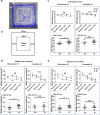Cerebellar irradiation does not cause hyperactivity, fear, and anxiety-related disorders in the juvenile rat brain
- PMID: 36376609
- PMCID: PMC9663786
- DOI: 10.1186/s41747-022-00307-8
Cerebellar irradiation does not cause hyperactivity, fear, and anxiety-related disorders in the juvenile rat brain
Abstract
Background: The cerebellum is involved in hyperactivity, fear, and anxiety disorders that could be induced by whole-brain irradiation (WBI). However, whether cerebellar irradiation alone (CIA) could induce these disorders is unknown. We investigated the effect of CIA in an animal model.
Methods: Eleven-day-old rat pups underwent a single 3-Gy dose of either WBI (n = 28) or CIA (n = 20), while 34 rat pups were sham-irradiated (controls). Cell death was evaluated in the subgranular zone of the hippocampus by counting pyknotic cells after haematoxylin/eosin staining at 6 h after irradiation for 10, 8, and 9 pups, respectively. Behavioural changes were evaluated via open-field test at 6 weeks for 18, 12, and 25 pups, respectively. Unpaired two-tailed t-test and one-way and two-way repeated ANOVA were used.
Results: Massive cell death in cerebellar external granular layer was detected at 6 h after CIA (1,419 ± 211 mm, mean ± S.E.M. versus controls (68 ± 12 mm) (p < 0.001)), while no significant difference between CIA (1,419 ± 211 mm) versus WBI (1,433 ± 107 mm) (p = 0.955) was found. At open-field behavioural test, running distance, activity, wall distance, middle zone visit times, and duration were higher for WBI versus controls (p < 0.010), but no difference between CIA and controls was found (p > 0.05).
Conclusions: Although the cerebellum is involved in hyperactivity, fear, and anxiety disorders, CIA did not induce these disorders, indicating that WBI-induced cerebellar injury does not directly cause these behavioural abnormalities after WBI. Thus, targeting the cerebellum alone may not be enough to rescue or reduce these behavioural abnormalities after WBI.
Keywords: Anxiety; Cerebellum; Hyperactivity; Models (animal); Radiotherapy.
© 2022. The Author(s) under exclusive licence to European Society of Radiology.
Conflict of interest statement
The authors declare that they have no competing interests.
Figures





Similar articles
-
Minocycline ameliorates cognitive impairment induced by whole-brain irradiation: an animal study.Radiat Oncol. 2014 Dec 12;9:281. doi: 10.1186/s13014-014-0281-8. Radiat Oncol. 2014. PMID: 25498371 Free PMC article.
-
Cerebellar modulation of memory encoding in the periaqueductal grey and fear behaviour.Elife. 2022 Mar 15;11:e76278. doi: 10.7554/eLife.76278. Elife. 2022. PMID: 35287795 Free PMC article.
-
Cerebellar parameters in developing 15 day old rat pups treated with propylthiouracil in comparison with 5 and 24 day old.East Afr Med J. 2001 Jun;78(6):322-6. doi: 10.4314/eamj.v78i6.9027. East Afr Med J. 2001. PMID: 12002112
-
The cerebellum in fear and anxiety-related disorders.Prog Neuropsychopharmacol Biol Psychiatry. 2018 Jul 13;85:23-32. doi: 10.1016/j.pnpbp.2018.04.002. Epub 2018 Apr 6. Prog Neuropsychopharmacol Biol Psychiatry. 2018. PMID: 29627508 Review.
-
Cooperation of the vestibular and cerebellar networks in anxiety disorders and depression.Prog Neuropsychopharmacol Biol Psychiatry. 2019 Mar 8;89:310-321. doi: 10.1016/j.pnpbp.2018.10.004. Epub 2018 Oct 5. Prog Neuropsychopharmacol Biol Psychiatry. 2019. PMID: 30292730 Review.
Cited by
-
The sex-dependent impact of PER2 polymorphism on sleep and activity in a novel mouse model of cranial-irradiation-induced hypersomnolence.Neurooncol Adv. 2023 Sep 4;5(1):vdad108. doi: 10.1093/noajnl/vdad108. eCollection 2023 Jan-Dec. Neurooncol Adv. 2023. PMID: 37781088 Free PMC article.
References
Publication types
MeSH terms
LinkOut - more resources
Full Text Sources
